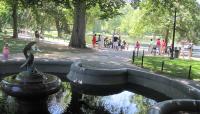Landscape Information
Originally established on the former mudflats of Boston’s Back Bay by horticulturalist Horace Gray in 1837, the first public botanical garden in America was not fully realized until the late nineteenth century. Although many proposals were generated during its initial decades, only simple modifications were made until 1859 when the land was secured for park purposes, in response to the proposals for a ‘Central Park’ in New York. That same year, a design by architect George Meacham was selected. Employing formal and Picturesque elements, Meacham’s plan included geometrical flower beds, a central building on axis with an ornate bridge, a playground, fountains, and pedestrian paths. The plan was adapted by city engineer James Slade who replaced the building with an equestrian statue of George Washington (1864) by Thomas Ball. Construction was completed by the 1860s. The park’s iconic swan boats were added in 1877. Improvements over time included the conversion of a peninsula, situated along the north side of the pond, into an island and the regrading of the eastern border along Charles Street in 1895. The Public Garden, and the adjacent Boston Common, serves as the northern terminus of the Emerald Necklace park system, designed by Frederick Law Olmsted, Sr. Various sculptures have been added over time. In 1970 community members established the Friends of the Public Garden to improve Boston’s declining parks, including the garden. In 1972, the garden was listed in the National Register of Historic Places and was designated a National Historic Landmark in 1987.

















